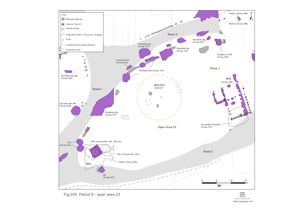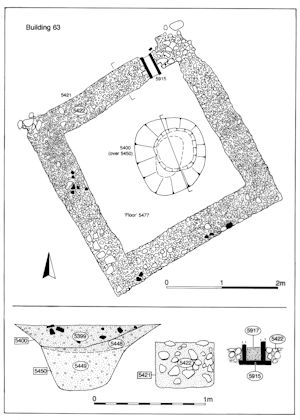
The earlier part of Period 6 in Open Area 23 is characterised by continuity from Periods 4 and 5 (Figure 204). It is not until the removal of the Structure 46 precinct wall that significant change is wrought to the temple complex. This identifiably later activity is described in Central zone, Open Area 23.
During the late 4th century, at least, the precinct retains its form and identity. Roads 1 and 2 are assumed to remain as an active, though unmaintained and deteriorating, thoroughfare so providing a western limit, and boundary structures may well survive along the remains of defunct Roads 3 and 4.

The circular temple continues to occupy the centre of the precinct and is assumed to stand as a functioning building. Certainly, no Late or latest Roman features either cut or overlie the structure or lie within its interior. Indeed, the lack of encroachment of late activity into the precinct is noteworthy. As in Period 5, late 4th-century depositional activity is restricted to its boundaries and seems to be a direct continuity of practice. Building 63 is the only significant addition to the enduring temple complex.

Building 63 is a small, 3.5m square, building that is inserted into the western extreme of the precinct, adjacent to the junction of Roads 1 and 2. Its foundation trench 5421 (Group 450), 0.5m wide and 0.4m deep, is packed with large flint pebbles, septaria rubble and tile in a silt fill. The trench is continuous, with no suggestion of the position of a doorway and no indications of the nature of the building above its footings, such as post-settings within the trench. However, the foundation incorporates a tile-built vent or drain 5915 (Group 451) toward the northern corner of the building, which probably sits at around contemporary ground level (Figure 205). The interior of the building is surfaced with a 0.2m-thick layer of small flint pebbles and silt 5477 (Group 449), through the centre of which small pit 5450 (Group 452) is cut. The pit is only 0.3m deep but contains a lead disc (SF2109) and 722g of lead waste (SF2105, SF2258, SF8387) in its upper fill. Apart from these items, the finds content of this feature is seemingly insignificant.
Although at the time of excavation it was speculated that Building 63 was used for metalworking, primarily the casting of lead objects, this is perhaps unlikely. While pit 5450 could be a hearth, or a fire-pit below such a hearth, with 're-cut' 5400 perhaps relating to its disuse and the reconstitution of the floor, it is more probably simply a pit that happens to contain discarded lead splatters. Copper-alloy balls (SF2027, SF2108, SF2257) are present in pit 5450 and the overlying layer 5387 (Group 455).
This building could represent a change in the use of this space to the 'rear' of the temple, though its function is not established. Its position in proximity to the Road 2/3 Junction is probably significant, the structure perhaps in effect looking onto the main road through that part of the settlement west of the religious focus.
The decay of the fabric of the eastern temple precinct wall (Structure 46) is demonstrated by the accumulation of mainly rubble and tile deposits (21619, 21620, 21666, 21668, 21756, 21878, 21979 Group 446) at the foot of the wall. Although only two deposits (21878, 21979) seem to represent in situ collapse, it is assumed that the other rubble layers derive from the same process. There is some evidence for a period of silty accumulation over the rubble. However, at some point a desultory attempt is made to remove or rob the wall line (21815/21929, 21944, 22169 Group 447). 21815 is a shallow trench of about 1.6m width and never more than 0.20m deep. It follows the line of wall foundation 21810, extending about 15m; essentially the whole south half of the former wall. If it is a robbing attempt, it is not pursued very hard and plenty of wall foundation is left below it. 21944 is a less convincing and more restricted 'robbing' cut at the north end of the wall.
It may be more appropriate to call these 'clearance' or 'tidying' episodes rather than 'robbing'. As described in Period 5, the precinct wall has a history of structural problems and required extensive repair; this episode may merely mark the final decay and removal of the wall. The clearance undertaken is minimal in order to prepare the ground for the subsequent construction of Building 64 over the southern part of the former wall line.
The only deposits representing latest Roman layers or use accumulations within the precinct interior are 5429 and 13873 (Group 445). Both survive within the slump hollows of earlier features and are presumably the last vestiges of once extensive deposits. Deposit 5429 may be associated with the occupation of Building 63, as it accumulates against its east wall.
The latest Roman pits (5179, 5209, 5341, 5379, 5509 Group 442, 5180, 5189, 5359, 5471 Group 443, 5736, 5805 Group 444) closely follow the patterning of those of Period 5, being generally large and located along the edge of Road 4. Many of these are of distinctive elongated plan, which suggests that the pits are deliberately and tightly restricted within the confines of the precinct and are not permitted to encroach upon the adjacent thoroughfare. At the north-east edge of the precinct in particular, the elongated pits almost resemble a discontinuous roadside ditch. Indeed, the most extremely elongated pits (5359 and 5471) have an almost rectilinear, slot-like appearance and may indeed be boundary features or pits with a specific function in association with the boundary. The various personal items and tools in pit 5359, including a bone hairpin (SF1903), copper-alloy nail cleaner (SF6842) and various pieces of ironwork, may comprise a structured deposit.
The finds assemblages from these latest Roman pits are very similar to those of Period 5 and perhaps serve to show, like their distribution, that these are a continuation of the same depositional trend. Pit 5509 contains KPG37 (fill 5210) dated to c. AD 350-400. Significantly, a number of pits contain artefacts that may constitute votive offerings. Pit 5179 includes face-flagon and shale bracelet fragments, pit 5341 chicken bones, pit 5509 five coins, pit 5805 tools, keys, a hairpin and many iron nails. Most convincingly, pit 5209 contains twenty coins, iron tools, a glass bead, 8kg of oyster, and chicken bones. Furthermore, the range of 'waste' iron, copper and lead present, large numbers of coins, and deposition of face-pots in these latest pits is reminiscent of the assemblage from OA18 northern boundary ditch 25027 (Group 838 Period 5), which could also possibly be the product of votive deposition.
It may be worth noting that pits 5180 and 5209 also contain fragments of burnt glass. Pit 5180 has a rim fragment from a pillar-moulded bowl that is melted on its inside surface. Pit 5209 has a quantity of burnt fragments all from the same vessel - probably a cup. Further speculation about their significance is presented in Vol. 1, Chapter 6.
Internet Archaeology is an open access journal based in the Department of Archaeology, University of York. Except where otherwise noted, content from this work may be used under the terms of the Creative Commons Attribution 3.0 (CC BY) Unported licence, which permits unrestricted use, distribution, and reproduction in any medium, provided that attribution to the author(s), the title of the work, the Internet Archaeology journal and the relevant URL/DOI are given.
Terms and Conditions | Legal Statements | Privacy Policy | Cookies Policy | Citing Internet Archaeology
Internet Archaeology content is preserved for the long term with the Archaeology Data Service. Help sustain and support open access publication by donating to our Open Access Archaeology Fund.